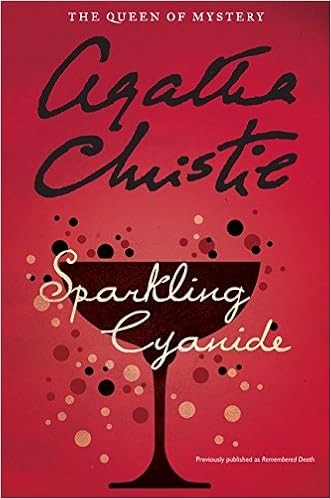Cyanide, also known as Prussic Acid, is one of the most notorious and deadly poisons. As hydrogen cyanide gas, it can be an instrument of mass murder and when swallowed in solid form, it causes a quick, nasty death. It's the legendary "poison pill" that spies are supposed to swallow if captured.
It does not leave a pretty corpse. The victim often froths at the mouth.
Cyanide occurs in nature in many benign plants like apple and orange seeds, almonds, apricot kernels, bamboo shoots and cassava. Some insects also release cyanide as a protective mechanism.
-Manet.jpg/800px-Gypsy-with-Cigarette-(1862)-Manet.jpg) |
| Tobacco smoke contains cyanide |
Hydrogen cyanide is present in tobacco and wood smoke, and burning plastic can send off enough of the toxic gas to make people sick or even kill. A hydrogen cyanide concentration of 300 mg/m3 in the air will kill in as little as 10 minutes.
A hundred grams (about a quarter of a pound) of dried, crushed apple seeds yields about 50-70 mg of cyanide, which is enough to kill. But that's a lot of apples! Maybe your murderer could be a pie baker or a cider-maker....hmmm.
Cyanide kills by preventing the body from absorbing oxygen. The victim will first feel a headache, dizziness, vertigo and confusion. They will then have difficulty breathing and lose consciousness before suffering cardiac arrest. The face may turn a cherry red. A fatal dose for humans can be as low as 1.5 mg/kg body weight.
 |
| Apple seeds contain cyanide |
The most common antidote, which must be administered immediately, is amyl nitrate, followed by intravenous sodium nitrate and sodium thiosulfate.
It was first isolated as a component of the blue pigment, "Prussian blue" and sodium cyanide and potassium cyanide have been used for centuries in gold and silver mining and for electroplating. Cyanide has been long used as a pesticide, and has many industrial applications, including photography processes, like sepia toning. (So maybe the wedding photographer is the murderer?)
 |
| Bitter almonds contain 42 X the cyanide of sweet almonds |
Probably because it acts so fast, it's one of the most popular poisons with mystery writers. Agatha Christie used it in numerous novels, including Sparkling Cyanide and And Then There Were None. Raymond Chandler used it in The Little Sister and Ngaio Marsh used it in Death at the Bar.
In the Doctor Who episode about Agatha Christie, The Unicorn and the Wasp, the Doctor himself is poisoned with cyanide, but with his Gallifreyan metabolism, he was able to detoxify himself.
Some people think the fictional poison "the Strangler" in Game of Thrones is based on cyanide, although others think it's more like strychnine.
Do you have a favorite poisoning mystery? What poison was used?
Other Posts in this Series
This week we have a very special deal. The first three books in the Camilla Randall series are available for 99c--that's 33c per book!
 THE CAMILLA RANDALL MYSTERIES
THE CAMILLA RANDALL MYSTERIES
Ghostwriters in the Sky, Sherwood, Ltd. and The Best Revenge in a boxed set.
"Delicious wit, wonderful eccentric characters, and a beguiling plot. Camilla Randall is a delight!"...Melodie Campbell, "Canada's Queen of Comedy."
These mysteries are a laugh-out-loud mashup of romantic comedy, crime fiction, and satire: Dorothy Parker meets Dorothy L. Sayers. Perennially down-and-out socialite Camilla Randall a.k.a. "The Manners Doctor" is a magnet for murder, mayhem and Mr. Wrong, but she always solves the mystery in her quirky, but oh-so-polite way. Usually with more than a little help from her gay best friend, Plantagenet Smith.
99c or the equivalent from:
And it's at the regular price of $3.99 at these retailers:

I watch a lot of Lifetime movies and Forensic Files and my favorite "gross" murders are from arsenic poisoning. I can't believe how many there are. It's amazing.
ReplyDeletePatricia--I forgot to put in the links to the previous posts in the series, so I just did. :-) I think arsenic is the most popular poison in classic mysteries. Probably because it used to be found in pretty much every household for poisoning rats and mice, so it was always handy.
DeleteHmm...good question. I watch a lot of true crime. Homicide Hunter is my favorite. He's had a few poisoners that used ethylene glycol. Not smart. It's easily detectible. But it's a brutal death.
ReplyDeleteSue--Thanks! I'll have to check out ethylene glycol. That's not one of the Agatha Christie poisons that I recall, but it's probably more up to date.
DeleteThere was an old (1944) movie directed by Frank Capra and starring Cary Grant about a nutcase family with well-intentioned homicidal tendencies called Arsenic And Old Lace. "You'll die laughing" was the tag line.
ReplyDeleteRuth--One of my favorite movies of all time! I have a still shot from it in my post on arsenic. I always wanted to play one of those murderous old dears in the stage play.
Deletethe Garlic Mustard plant has high levels of cyanide. Is it ever mentioned in murder mysteries?
ReplyDelete